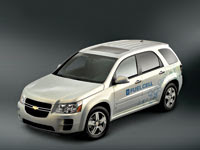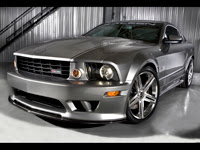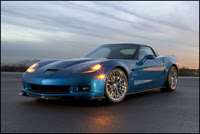
According to the Merriam-Webster dictionary, the definition of the word “genesis” is
as follows: the origin or coming into being of something. There couldn't be a better name or a more apt description of Hyundai's new flagship vehicle than Genesis. For years Hyundai has upped its game, focusing on quality, durability and reliability, and has succeeded. Now it's confident enough in its progress to charge into previously uncharted territory. This brand, which wasn't even much more than a bottom feeder in North America some twenty years ago, is now a major threat to the biggest and most established players in the industry. So, it's going to be a very important occasion when this brand launches its flagship car, a vehicle that will no doubt set the standard for affordable luxury.
The image that Hyundai has been building up recently has been more refined and sophisticated, and for its flagship? The styling, well, it's easy on the eyes, but it isn't exactly distinctive. From the front, there's a lot of Mercedes-Benz S-Class in the grille and quite a bit of Lexus LS 460 in the headlamps. From the side, it sort of looks like an Infiniti G, and from the rear there are hints of BMW 5- and 7-Series. Mind you, the fact that Hyundai
is drawing from some of the best-known brands in the luxury sector is no bad thing, it's just that the car doesn't have much Hyundai design character to it.
To be fair, however, after about 20 years of sales success, Toyota's Lexus division only just started offering cars with unique styling, with its initial cars paying much homage to Mercedes-Benz. Still, at least Lexus made it possible to distinguish its brand identity when an ES or LS was traveling toward you. To further confuse onlookers as to what the Genesis is, you probably have noticed that it's completely unbadged from the front. This is sure to raise questions. As one of our staff pointed out, what sort of flagship is too embarrassed to wear the company logo? This is the equivalent to a famous painter intentionally not signing his or her masterpiece, a mistake Hyundai previously made with its XG300 and 350, corrected with the Azera. A small, discreet badge centered on the grille's topmost chrome strip would be enough, and help change Hyundai's image on the street when pedestrians catch sight of the car while walking by.A different tone is set by the Genesis' interior, and a much more impressive one at that. The first thing that will catch most people's eyes is something that isn't found on any other Hyundai – a navigation screen. This will be the first Hyundai offered here in North America to get one, and bodes well for other Hyundai models that are currently lacking this feature. A series of controls sits below the screen, a similar layout to what can be found in the Infiniti G and M, although these controls do not operate the hi-fi system and navigation. To control these, Hyundai has conjured up its own version of iDrive, which is mounted behind the shifter.
We'll have
to wait to test it in order to judge how easy the system is to use. Next up, you'll find that there's a lot of quality material in the car. Hyundai has escalated its fit and finish and materials over the years, but this is set to be the finest car that they've made. The dashboard, door panels and other areas of trim are covered in leather, and stitched to create a first-class impression, and yes, there's plenty of authentic wood and aluminum trim too. Alhough Hyundai will compete against the Pontiac G8 and Chrysler 300 when it comes to pricing, it's got Lexus, BMW and Mercedes-Benz in its targets, and has engineered the Genesis to be competitive even though it will be priced tens of thousands of dollars cheaper than its rivals. The Genesis is Hyundai's first rear wheel drive car for North America, so they've developed it completely from scratch. Its body structure, constructed from high tensile steel, is reportedly more rigid yet lighter than a 5-Series or an E-Class, despite the fact that it's physically a much bigger car. Besides being rear wheel drive, the Genesis also features a five-link, multi-link rear
suspension and will be available with adaptive damping to deliver a supple yet sporty ride. How sporty? According to Hyundai Director, Product Planning Wayne Killen, discussing the car on the show floor with our exec editor Trevor Hofmann, the Genesis fits right in between the 5-Series and E-Class, with tighter handling that would be more appreciated by BMW drivers, adding, it's more Infiniti M than Lexus GS, if the Euro comparo wasn't enough. This certainly will have to be experienced first hand. The Genesis comes standard with 17-inch wheels, while 18-inchers are an option.The highlight of the Genesis is the brand new Tau V8 engine, and although it isn't the first V8 offered by for the brand (a previous, Korean domestic market car built with Mitsubishi offered V8-power), this is the first V8 the brand will be selling here in North America. The 32-valve engine is stated to make 368 horsepower and 324 lb-ft of torque. And if the thought of a Hyundai hitting 60 mph in less than six seconds isn't impressive enough, the fact that it's capable of doing all of this yet still running on regular unleaded should. If premium fuel is used, output is said to jump to 375 horsepower. You'll be seeing more of the Tau engine in the future, as Hyundai has designed it to be modular and to accept new technologies like forced aspiration and direct injection. The Tau's power and torque are connected to the rear wheels via a ZF six-speed gearbox with manual mode, the same transmission found in many high-end luxury cars.
Being that not everyone wants or needs V8 power, the Genesis will also be available with two alternative V6 engines, both of which are from the Lambda family. The sixes offer more power than the current versions of the same displacement they're derived from, thanks to revisions to their variable intake manifolds and the addition of advanced continuously variable valve timing. The midrange engine is the 3.8-liter V6 now found in the Azera and Veracruz, although in Genesis trim it puts out an impressive 290 horsepower and 264 lb-ft of torque. The entry level Genesis is powered by a smaller 3.3-liter V6 engine, currently available in the Sonata, Santa Fe and Veracruz, but for the Genesis it will make 268 horsepower and 233 lb-ft of torque - most likely these upgraded V6s will replace the current versions throughout the range; the smallest engine will most likely not make it to North America, mind you. And this is a big leap forward in performance, considering that the Azera's current 3.8-liter V6 makes 263 horsepower and the 3.3 puts out a max of 242. Like the V8, the V6 is linked to a six-speed automatic, unlike the current five-speed unit, although it is supplied by Aisin rather than ZF. Now that I'm talking Azera, it's important to note that the Genesis was not designed to replace the current front-wheel drive flagship, but to complement it. The Azera will continue on due to strong sales and it's ability to reach a different type of client than the Genesis will attract, kind of like how Lexus captures a larger share of the midsize luxury market with its ES 350 and LS 350 models.If luxury is defined by toys, the Genesis could very well be at the top of the heap. It has all the usual accoutrements like heated and ventilated seats, proximity sensing keyless access with pushbutton start, adaptive xenon headlamps and even an HD
Radio as standard equipment. Still, as impressive a list as this is, it's the less noticeable details that count for more in this game. Take for instance the leather on the steering wheel, which has been treated with UV-reflective dyes so that the surface doesn't become too hot to touch. If music is an important part of your drive the Genesis could be the car for you, as it can be had with an upgraded sound system that showcases 17 Lexicon speakers that are fed info from the Harman/Kardon Logic7 receiver with music selected from the six-disc CD player, the 30 gb hard drive, or your iPod via a USB slot.
Logic7 can be found in some of the world's finest cars, like the Range Rover, S-Class and 7-Series. Lexicon speakers can only be found in what's widely regarded as the finest luxury sedan in the world, the Rolls-Royce Phantom. And soon, of course, the Genesis. If it is possible to capture a brand's will and desire in automotive form, the Genesis is Hyundai's. Although it represents a standard never before seen in a Korean car, it has not lost forgotten the brand's core value proposition, delivering bang for the buck. The new Genesis will start at under $30,000 dollars, and will have an industry-leading warranty. Its introduction in Detroit will no doubt be a proud moment, but the real success will be when customers get behind the wheel and drive it this summer. We certainly look forward to doing likewise.






















